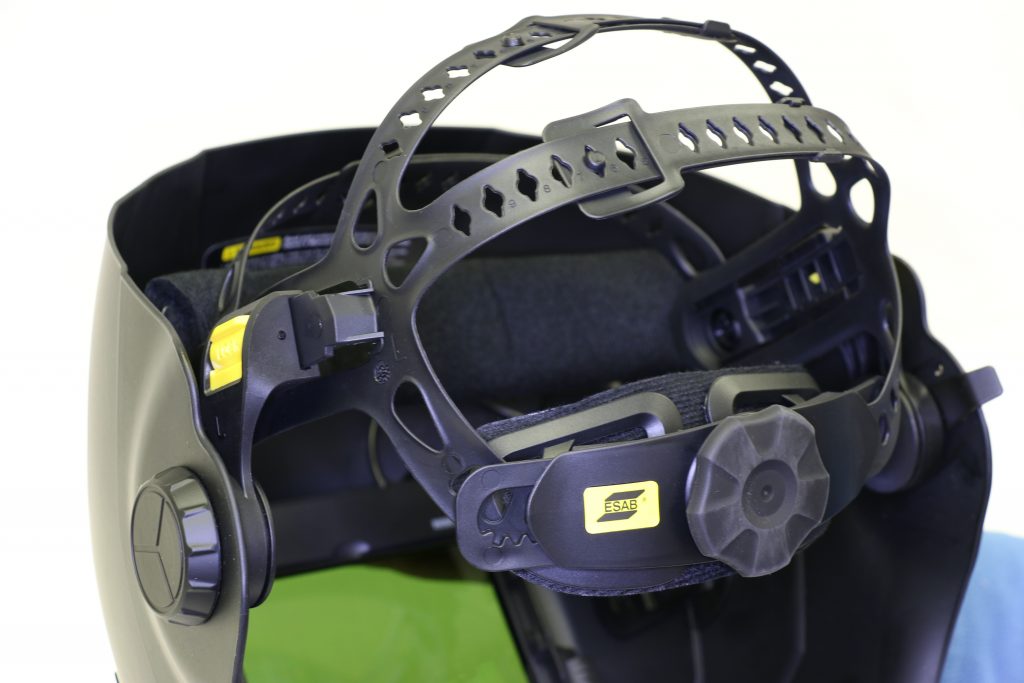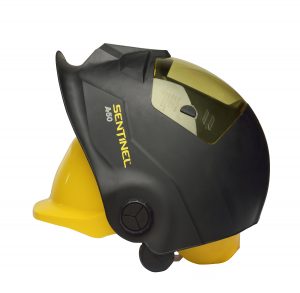Comfort and Balance
Like a good pair of work boots, fit is crucial, with the headband providing primary contact points on the forehead, the back of the head and over the top of the head. A typical helmet has three points of contact and about 100,000 possible adjustment combinations. Next generation helmets have headgear that provides five points, which better distributes the perceived weight. It also provides greater adjustability — more than 500,000 possible combinations in total.
For operators that work in tight areas (process piping, plant maintenance and shipbuilding come to mind), note that a helmet with a lower pivot point will reduce the chance of catching the helmet on an obstruction.

ADF Lens Technology
The heaviest component of a helmet is its auto-darkening filter, or ADF. While oversize viewing areas have been popular, many operators say that a viewing area of in the neighborhood of 4 x 2.5 in. works just fine for seeing the joint while helping reduce weight and keeping the helmet more affordable. Incidentally, larger viewing areas also increase price because the ADF typically accounts for 60 to 70 percent of a helmet’s cost.
Today’s top-end lenses switch from a light to dark state at speeds of 1/25,000 of a second and faster. To put this in perspective, the human eye takes 3/10th to 4/10th of a second to blink. Further, the lens has a permanent passive filter to protect against UV and IR light. Even if the ADF fails to darken, the UV and IR filter helps protect the eye.
Because the U.S. does not follow a standard for clarity, many of the domestic helmet providers have adopted the European Norm (EN) 379 Standard, which sets performance requirements for optical quality and evaluates them on a scale of 1 to 3, with class 1 being the highest. The four factors that determine quality are:
 Optical quality 1, 2 or 3 – indicates optical quality of the ocular.
Optical quality 1, 2 or 3 – indicates optical quality of the ocular.- Light diffusion class (switchable filters only) – indicates light diffusion by the ocular.
- Variation in luminous transmittance (switchable filters only) – indicates shade variability in the dark state of the ocular.
- Angle of dependence of luminous transmittance (optional) – if applicable, marked before the standard number.
EN 379 Standard states that the highest optical classification is 1/1/1/1. That said, helmets with a 1/1/1/2 optical class rating, offers a sharp, clear and consistent view of the weld puddle without the extra cost to obtain the angle dependency 1 rating, a difference that most operators find difficult to perceive.
Reading the Puddle
Until 2008, most ADFs created a greenish cast that muddled the varying shades of red in the weld puddle and the heat-affected zone (HAZ). Newer ADFs offer more of a true color perception, transmitting a blue tint from the weld and actually emitting more light than from a green tint transmission. Recognizing true color helps operators better read the weld puddle and the HAZ, critical factors for puddle control and bead placement.
To further help operators, some helmets offer front lens covers in clear and amber. An amber tint can improve contrast between the weld puddle and the rest of the joint, as well as enhance the light in low-light conditions.
Of course, ADF shade affects view the most. Newer top-tier helmets offer range of 5 to 13. The lower ranges help when TIG welding at low amperage, when using small diameter electrodes at lower amperages and when plasma or oxy-fuel cutting (cutting goggles and glasses often come in shade 5). Some of helmets also offer a “grind mode” of shade 3.5 or, most commonly, shade 4. Welding helmets with modes for welding, cutting and grinding replace the clutter of different PPE for these tasks and eliminate downtime when switching between applications.
Control Functions
Other helmet control functions include “sensitivity,” which adjusts how much light it takes the ADF darken. This function particularly helps when welding outdoors, where sunlight can cause the ADF to darken before the operator strikes and arc. The “delay control” function enables the operator adjust how long it takes the lens to react after the operator breaks arc, such as from 0.1 to 1.0 second in 0.1 increments. This function helps in high-amperage applications (notably Flux-Cored welding with large diameter wires), as it keeps the lens dark a fraction of a second longer to give the weld puddle a chance to cool and lose some of its “cherry red” intensity.
Some ADFs also provide memory functions to store pre-selected settings for shade, sensitivity and delay. For operators who frequently switch between applications (such as from low-amp TIG to high-amp TIG to Stick to MIG to Flux-Cored), the memory function eliminates fiddling around with settings before welding (and, being honest, lets operators weld with the optimum settings instead of just making do with a less-than-acceptable setting).

Sensors and Batteries
Typically, ADFs have either two or four sensors located in the corners of the cartridge. Professional welders prefer helmets with four sensors, especially if they weld out of position, because having more sensors reduces the likelihood of blocked sensors. Some top-tier also use electromagnetic arc sensors that automatically react to the magnetic field of the arc.
To change from a light to dark state, ADFs use a variety of technologies, including solar power and lithium batteries. There is a widespread misconception that the solar power recharges the batteries; that’s not true. Rather, after the battery provides the power for the ADF to darken, then solar power provides a supplemental power stream to the keep the ADF darkened.
Purchasing a top-tier welding helmet involves spending $250 to $350. Following the suggestions above will help guide users to an informed decision. Speaking from a corporate perspective, note that choosing a good helmet doesn’t just improve operator productivity and comfort, it goes a long way toward enhancing operator satisfaction — and happy operators are always more productive.
About ESAB
ESAB is a world leader in the production of welding and cutting equipment and consumables. Their innovative, world-renowned equipment and solutions are developed with input from our customers and built with the expertise and heritage of a global manufacturing leader. The ESAB brand is synonymous with world leading expertise, manual welding and cutting equipment, welding consumables, welding automation, and mechanized cutting systems.


















